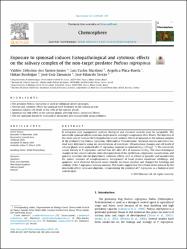| dc.contributor.author | dos Santos-Junior, Valdeir Celestino | |
| dc.contributor.author | Martinez, Luis Carlos | |
| dc.contributor.author | Plata-Rueda, Angelica | |
| dc.contributor.author | Bozdogan, Hakan | |
| dc.contributor.author | Zanuncio, Jose Cola | |
| dc.contributor.author | Serrao, Jose Eduardo | |
| dc.date.accessioned | 2019-11-24T21:00:08Z | |
| dc.date.available | 2019-11-24T21:00:08Z | |
| dc.date.issued | 2019 | |
| dc.identifier.issn | 0045-6535 | |
| dc.identifier.issn | 1879-1298 | |
| dc.identifier.uri | https://dx.doi.org/10.1016/j.chemosphere.2019.03.105 | |
| dc.identifier.uri | https://hdl.handle.net/20.500.12513/3373 | |
| dc.description | WOS: 000467668500074 | en_US |
| dc.description | PubMed ID: 30903844 | en_US |
| dc.description.abstract | In integrated pest management systems, biological and chemical controls must be compatible. The insecticide spinosad affects some non-target insects and might compromise their fitness. The objective of this study was to evaluate the histopathological and cytotoxic effects of spinosad on the salivary complex of the predatory bug Podisus nigrispinus (Heteroptera: Pentatomidae). Spinosad toxicity and insect survival were determined using six concentrations of insecticide. Ultrastructural changes and cell death of salivary glands were analyzed after P. nigrispinus exposure to spinosad LC50 (3.15 mu g L-1). The insecticide caused toxicity to P. nigrispinus; survival was 32% after 48 h of exposure to LC50. The main histological changes in the salivary complex were disorganization of the epithelium, cytoplasmic vacuolization, and apocrine secretion into the gland lumen. Cytotoxic effects, such as release of granules and vacuoles into the lumen, presence of autophagosomes, enlargement of basal plasma membrane infoldings, and apoptosis, were observed. Spinosad causes toxicity, decreases survival, and changes the histology and cytology of the P. nigrispinus salivary complex. The results suggest that the cellular stress induced by the insecticide affects extra-oral digestion, compromising the potential of P. nigrispinus as a biological pest control agent. (C) 2019 Elsevier Ltd. All rights reserved. | en_US |
| dc.description.sponsorship | Brazilian National Council for Scientific and Technological Development (CNPq)National Council for Scientific and Technological Development (CNPq); Coordination for the Improvement of Higher Education Personnel (CAPES)CAPES; Minas Gerais Research Foundation (FAPEMIG)Minas Gerais State Research Foundation (FAPEMIG) | en_US |
| dc.description.sponsorship | We thank the Brazilian National Council for Scientific and Technological Development (CNPq), the Coordination for the Improvement of Higher Education Personnel (CAPES), and the Minas Gerais Research Foundation (FAPEMIG) for the financial contribution. We also thank the Center for Microscopy and Microanalysis of the Federal University of Vicosa for the technical support. | en_US |
| dc.language.iso | eng | en_US |
| dc.publisher | PERGAMON-ELSEVIER SCIENCE LTD | en_US |
| dc.relation.isversionof | 10.1016/j.chemosphere.2019.03.105 | en_US |
| dc.rights | info:eu-repo/semantics/closedAccess | en_US |
| dc.subject | Apoptosis | en_US |
| dc.subject | Extra-oral digestion | en_US |
| dc.subject | Non-target organism | en_US |
| dc.subject | Salivary gland | en_US |
| dc.subject | Toxicity | en_US |
| dc.title | Exposure to spinosad induces histopathological and cytotoxic effects on the salivary complex of the non-target predator Podisus nigrispinus | en_US |
| dc.type | article | en_US |
| dc.relation.journal | CHEMOSPHERE | en_US |
| dc.contributor.department | Kırşehir Ahi Evran Üniversitesi, Teknik Bilimler Meslek Yüksekokulu, Bitkisel ve Hayvansal Ürünler Bölümü | en_US |
| dc.identifier.volume | 225 | en_US |
| dc.identifier.startpage | 688 | en_US |
| dc.identifier.endpage | 695 | en_US |
| dc.relation.publicationcategory | Makale - Uluslararası Hakemli Dergi - Kurum Öğretim Elemanı | en_US |


















